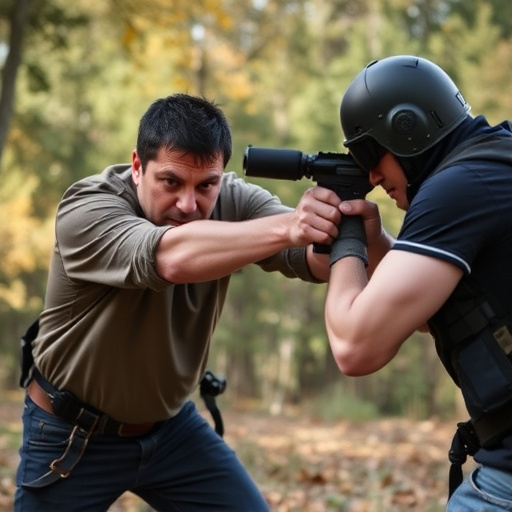Before using bear spray for defense, research local laws on carrying pepper spray, focusing on specific regulations for your region and activity. Choose a product with adequate active ingredients, range, and easy deployment. Practice proper application techniques while understanding legal restrictions to ensure safe use and avoid repercussions. Implement post-exposure safety measures by storing the spray securely, inspecting it regularly, and practicing hygiene to mitigate risks of damage or transfer of capsaicin.
“Bear spray has emerged as a vital tool for outdoor enthusiasts navigating wild territories. This article guides you through the essentials of bear spray defense, focusing on legal considerations and practical application. Learn how to choose the right pepper spray tailored to your needs, master effective application techniques to deter aggressive bears, and understand post-exposure safety measures. Additionally, we’ll explore regional differences in laws surrounding the legal carrying of pepper spray, ensuring you’re prepared and compliant.”
- Understanding Bear Spray Legalities
- Choosing the Right Pepper Spray
- Effective Application Techniques
- Post-Exposure Safety Measures
Understanding Bear Spray Legalities
Before considering bear spray as a defense against animal attacks, it’s crucial to understand its legalities. The rules around carrying pepper spray vary greatly depending on your location. In some areas, it may be entirely banned, while others permit its use for specific purposes like hunting or personal protection.
To legally carry pepper spray, you’ll need to familiarize yourself with your region’s regulations. This typically involves checking local and state laws, as well as any restrictions imposed by parks or wilderness areas. Understanding these legalities ensures not only that you’re complying with the law but also that you have a valid means of self-defense when needed.
Choosing the Right Pepper Spray
Choosing the right pepper spray is crucial for effective self-defense against animal attacks, especially bears. When selecting a bear spray, consider factors like active ingredients, concentration, range, and ease of use. Active ingredients vary, with some sprays using capsaicin alone while others combine it with other irritants for enhanced effectiveness. Concentration measures the amount of pepper in the spray, affecting its potency; higher concentrations offer better protection at longer ranges. Ensure the spray complies with local regulations on how to legally carry pepper spray, as laws vary by region and activity (hiking, camping, etc.).
Additionally, familiarize yourself with the spray’s range – the distance it can effectively disperse the chemical. A longer range provides more time for escape, but closer ranges might be necessary for intense encounters. Look for sprays that are easy to deploy in stressful situations, with features like simple triggers and quick release mechanisms. Always store pepper spray securely and keep it easily accessible during outdoor activities where bear encounters are possible.
Effective Application Techniques
Knowing how to effectively apply bear spray during an encounter is crucial for deterring and defending against animal attacks. First, ensure you legally carry pepper spray, understanding local regulations regarding its possession and use. Next, practice proper technique—hold the canister at close range (around 20-30 cm) and aim for the eyes, nose, and mouth of the approaching animal. Spray in short bursts, allowing time between applications to allow the spray’s effects to wear off slightly before reapplying, as continuous spraying can reduce its effectiveness.
Remember that proper usage goes beyond just having the canister; it involves a strategic approach to ensure your safety without unnecessarily endangering wildlife. Familiarize yourself with the laws and best practices surrounding bear spray defense, including when and where it’s legal to carry, how to store it properly, and what to do in case of accidental discharge or missed targets.
Post-Exposure Safety Measures
After acquiring and learning how to use bear spray effectively, ensuring post-exposure safety measures is paramount. Understanding local regulations on pepper spray possession and usage is crucial; know exactly how to legally carry pepper spray to avoid any legal complications. Each jurisdiction has its own set of rules, so familiarize yourself with the laws in your area before venturing into potential wildlife encounters.
Keep your bear spray accessible but secure – stored properly in a case, out of reach of children and pets, and easily retrievable when needed. Regularly inspect the spray for any signs of damage or expiration; replace it as per the manufacturer’s guidelines. Additionally, practice good hygiene after using pepper spray; wash your hands thoroughly to avoid any potential transfer of capsaicin to food or eyes.
Bear spray can be an effective tool for self-defense against bear attacks, but it’s crucial to understand local laws regarding its legal carrying. Knowing how to choose the right pepper spray and master application techniques is essential for maximizing its effectiveness. Always remember post-exposure safety measures for comprehensive protection in bear country. By following these guidelines, you’ll be well-prepared with this game-changing tool, ensuring your safety while navigating through potential bear encounters.
